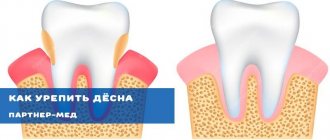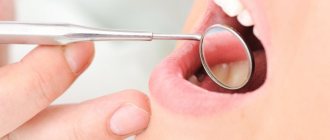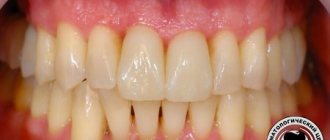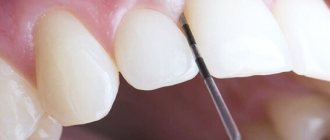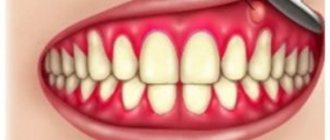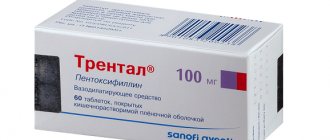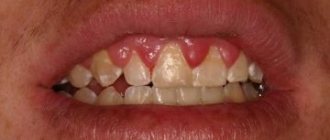WHAT IS PERIODONTAL
The periodontium is the complex of tissues surrounding the tooth. These include not only the gums, but also the bone socket in which the tooth root is located, and the tooth ligaments that hold the tooth in the socket, intertwined with the tooth root and bone. All these tissues represent a single system that performs several important functions at once: fixation of teeth, perception and regulation of chewing load, control of the work of masticatory muscles, protection against penetration of pathogenic bacteria and a number of damaging factors into the bone tissue.
Can periodontitis be cured?
The very first and most important thing you need to know is that treatment is only possible in combination. Many patients really try to solve the problem with their teeth - they periodically go for hygiene or curettage of the gums, maintain hygiene, and sometimes go to the doctor to prescribe medicinal dressings or injections. But, in fact, such treatment is only symptomatic and helps for a couple of months - for example, if you curettage the gums and splint teeth, but after that do not perform hygiene (either on your own or with a periodontist), do not give injections and do not use stimulating drugs. growth of the gum and bone tissue's own cells, there will be no effect - the splint will simply fall out along with the moving teeth.
Great news! Patients diagnosed with mild to moderate periodontitis are not hopeless! It is possible to stop the progression of the disease and stabilize the result for many years. But only with an integrated approach using the latest achievements in the field of periodontics and regenerating biomaterials.
Smile-at-Once integrated solutions for the treatment of periodontitis are an opportunity to save up to 80% of destroyed tissue!
- you will save your teeth and improve the appearance of your smile,
- you will become healthier, because we completely stop the spread of infection,
- we will restore bone tissue and stop tooth mobility,
- you will feel the effect immediately: the first results are noticeable after 7 days; up to 80% of tissues restored – in the first year,
- for each stage - its own course with individual drugs,
- maximum transparency - all procedures are included in the price,
- If the outcome is favorable, you will even be able to undergo implantation without the risk of rejection and while preserving your own teeth!
We protect teeth and gums from loss! We bring you back to life and guarantee results! Methods and drugs that have helped more than 2 million patients around the world.
Sign up now
HOW DOES GINGIVIT MANIFEST, AND WHY DOES IT OCCUR?
With superficial inflammation of the gums (if only soft gum tissue is involved in the process), we are dealing with gingivitis. Inflammation can occur in the area of 1 - 2 teeth (local gingivitis) or all teeth (generalized gingivitis).
Inflammation of the gums usually begins with damage to the gums, for example, when eating, brushing teeth, an incorrectly applied filling or crown, or a chemical burn. In this case, pathogenic microorganisms penetrate the injured gum and intensify the inflammatory response. The presence of soft plaque, tartar, and poor oral hygiene are mandatory conditions, and very often an independent cause of the onset and maintenance of the disease.
Gingivitis is often observed in people with malocclusions, crowded teeth and their incorrect position. A short frenulum of the upper and lower lips is also a risk factor for periodontal disease.
Smoking plays an important role (spasm of blood vessels occurs, gum nutrition deteriorates), decreased body defenses (immunodeficiency), lack of vitamin C and other risk factors.
In the acute stage of the process, pain, burning, swelling of the gingival margin, and bleeding when brushing teeth are usually noted. If the cause of the disease is not eliminated, then acute gingivitis becomes chronic, which does not go away on its own without treatment. In this case, the gums turn blue and periodically bleed when brushing your teeth and eating. There is an unpleasant odor from the mouth.
Severe forms of gingivitis, such as ulcerative gingivitis, are observed in severe general diseases of the body. For example, with diabetes or a serious immunodeficiency disease. In this case, the temperature rises, painful ulcers covered with a film appear on the dirty gray gums, and general health worsens.
With gingivitis, the teeth remain stable, since the process does not penetrate deep into the periodontium, the so-called periodontal pocket does not form, and the bone tissue of the tooth socket does not dissolve. Can there be consequences if gingivitis is not treated?
If gums are not treated in time, gingivitis will develop into periodontitis. This is a much more serious and dangerous disease than gingivitis. Often it becomes irreversible, since periodontitis affects and destroys the deep tissues of the periodontium - the ligaments of the tooth and the bone tissue of the jaw.
Diagnostics
The diagnosis of periodontitis is made on the basis of examination data, patient complaints, but always after performing an X-ray or computed tomography. Only an x-ray allows one to assess the extent of bone tissue resorption, that is, determine the stage of periodontitis and draw up a treatment plan. In case of a generalized process, an orthopantomogram is prescribed, that is, a panoramic photograph of the jaws. Sometimes a periodontist will recommend an in-depth examination to identify possible causes of periodontitis.
Differential diagnosis of periodontitis
Periodontitis has characteristic features that help distinguish it from other oral diseases. With gingivitis, the main symptom of which is inflammation of the gums, their hyperemia, swelling and bleeding, there are never periodontal pockets and loose teeth. With another periodontal disease, periodontal disease, there are no signs of inflammation and gum pockets. The main pathogenetic mechanism of periodontal disease is atrophy of periodontal tissue, which can expose the necks of teeth, making them more sensitive to irritants. Teeth become loose and fall out due to periodontal disease only in advanced cases.
WHAT FACTORS PROMOTE THE DEVELOPMENT OF PERIODONTITIS?
The causes of periodontitis are the same as those of gingivitis. Often periodontitis is associated with chronic gingivitis. If the traumatic factor persists, microorganisms actively continue to multiply in the damaged gum. Their toxins and enzymes destroy the gums deeper and deeper.
As a result, the connection between the gum and the tooth (the bottom of the periodontal sulcus) is disrupted - a very important protective formation that protects the tooth ligaments and bone from infection. A periodontal pocket appears, and now bacteria, plaque, etc. rush into the depths of the periodontium - this is where periodontitis begins. Next, gradual destruction of the tooth ligaments occurs, and the bone tissue melts.
Periodontitis can be acute or chronic. Typically, acute periodontitis occurs when there is deep, strong trauma to the gums (for example, a long artificial crown, a toothpick). In this case, the periodontal connection may be immediately disrupted - gingivitis and periodontitis occur simultaneously.
Generalized periodontitis is characteristic of serious general diseases of the body - diabetes, other endocrine diseases, radiation sickness, severe diseases of the gastrointestinal tract and cardiovascular system. It is almost impossible to cure such periodontitis without general treatment of the underlying disease.
In the chronic process, pain and swelling are not as pronounced as in acute periodontitis, the amount of tartar and soft plaque increases, the bad breath increases, the gums begin to settle, exposing the neck of the tooth, teeth become sensitive to cold, hot, sour and salty. Tooth mobility appears, unnoticeable at first, but steadily increasing.
Suppuration of periodontal pockets is often observed. Pus is released from under the gum when pressing on the gum edge with a finger. Sometimes, in the absence of outflow of pus, periodontal microabscesses occur - in this case, the patient already requires surgery.
Periodontitis can be one of the causes of some common diseases. The microorganism that causes stomach ulcers is often found in dental plaque. Other bacteria living in dental plaque can lead to the formation of microthrombi (blood clots). Penetrating into the blood (with bleeding gums), they increase the risk of cardiovascular diseases, including myocardial infarction. The entry of microorganisms into the blood can lead to septic endocarditis. There is information about the relationship between chronic dental and periodontal diseases and kidney damage. Remember that the focus of chronic infection in the oral cavity is the entry point for pathogenic bacteria into the body.
Forms and stages of periodontitis
According to the degree of manifestation
According to its manifestations, periodontitis can be acute (all the symptoms of the disease appear as clearly as possible), as well as chronic - in this case the manifestations are slightly smoothed out. As a rule, this is a sluggish and relatively easy process that does not particularly manifest itself in any way. But at the same time, inflammation continues to destroy periodontal tissue.
According to the reversibility of the process
In the initial form, the inflammation is superficial, but has spread deeper than with gingivitis. It manifests itself as pain when brushing and while eating, and small gum pockets are observed. If you turn to a specialist for help in time, this form of disease can be cured very quickly and easily, preventing its further development. But often patients don’t even go to the dentist - at most they use folk remedies, rinses, and limit themselves to changing the toothbrush and paste.
Due to the lack of comprehensive and high-quality treatment, the inflammatory process spreads throughout the entire dentition and “goes” deeper, gradually affecting the entire complex of periodontal tissues - this is already a chronic form. Patients usually complain only of bleeding gums, aching pain and bad breath. Some may notice the beginning of tooth mobility, the rapid formation of tartar, and a changed appearance of the smile. If systematic treatment is not carried out, then all manifestations of periodontitis will only increase.
According to the prevalence of the process
Inflammation in the area of 1-2 teeth is localized periodontitis; if it spreads to the entire dentition, it is generalized. Naturally, the latter form is more dangerous for teeth and requires more effort during treatment.
Stages of development of periodontitis
Stage I – mild or initial. Gingivitis, a superficial inflammation of the gums that the patient did not pay attention to, develops into this form. During this period, there is no severe pain, and the first signs are bleeding gums, slight itching, swelling of the mucous membrane, and a change in shade from pink to scarlet. The depth of the gum pockets is no more than 3.5 mm, there is no tooth mobility yet. Read more about the initial stage in a separate article.
Stage II – middle. The first signs intensify - the amount of plaque increases, it sinks under the gums, which provokes the formation of even more massive periodontal pockets. Their depth already reaches 4-5 mm. Pus accumulates inside, so the smell from the mouth becomes extremely unpleasant. The bone tissue is gradually destroyed, slight mobility of the teeth (grade I) appears, and gaps appear between them. Read more about this form of the disease at the link.
Stage III – advanced or severe. It is characterized by an increase in periodontal pockets of 5 mm or more, the addition of a bacterial infection and purulent inflammation of the contents. Bone tissue is destroyed, teeth are very mobile. Read more about the symptoms and possibilities of treatment and prosthetics at this stage in a separate article.
DIFFERENCES PERIODONTOSIS FROM PERIODONTITIS
Periodontal disease is a degenerative lesion of all periodontal tissues; this process never occurs in an acute form and is not associated with exposure to bacteria. There is a slow, uniform resorption of the bone tissue of the teeth cells and subsidence of the gums with exposure of the roots of the teeth. Periodontal disease is always a generalized process, that is, all teeth on both jaws are affected. Bone tissue atrophy is usually painless, continuous and, if left untreated, leads to the complete disappearance of the ligamentous apparatus, the walls of the tooth sockets and their loss. Inflammatory phenomena are associated with periodontal disease quite rarely.
The exact cause of the disease is still unknown. It is believed that the onset of the disease is associated with impaired blood circulation in periodontal tissues and endocrine disorders. The development of periodontal disease is promoted by diabetes, cirrhosis of the liver, gastric ulcer, neurogenic diseases, cardiovascular pathology (atherosclerosis), hypovitaminosis and a decrease in the body's overall resistance.
Local factors, for example, the impact of microorganisms on the periodontium, can only aggravate the course of the disease, therefore, in periodontal disease, the primary process is the resorption of bone tissue and the ligamentous apparatus of the tooth, and superficial changes in the gums are secondary.
Periodontal disease progresses slowly. Clinically, it manifests itself with significant changes in the periodontium. This is subsidence of the gums, exposure and increased sensitivity of the necks of the teeth, itching in the gums. Teeth remain stable for quite a long time.
A characteristic sign of periodontal disease is the presence of so-called wedge-shaped tooth defects - damage to the enamel of the teeth near the gums in the form of fairly deep oval cavities. Currently, this phenomenon is explained by a malnutrition of the tooth, inferior enamel and dentin, combined with very strong pressure on the toothbrush during frequent brushing. Periodontal disease is characterized by the absence of periodontal pockets.
Stages of tooth mobility during periodontitis: when there is a chance of salvation
Mobility can be normal or natural, which is needed for shock absorption during chewing loads, and it can be pathological, that is, abnormal. And the main cause is considered to be periodontitis. As the disease progresses, pathological mobility becomes one of the most striking clinical manifestations and dominates over all others - bleeding gums, destruction of bone tissue.
- I degree: mobility up to 1 mm in the direction from the tongue to the cheek/lips, sometimes the teeth also move sideways. The chances of saving teeth are high,
- II degree: mobility in the same directions, but deviations are already more than 1 mm. The chances of survival are average - therapy will be long-term,
- III degree: the tooth is already mobile in all directions, including vertical. It is extremely difficult to save teeth.
Some classifications also separately distinguish stage IV, in which the teeth rotate in their sockets and are on the verge of falling out completely. Their deletion is already shown here - you shouldn’t even try to save them.
“Often patients do not believe that periodontitis has progressed, because the teeth sometimes look quite normal in appearance, they have moved apart a little, but they still stand and serve. In fact, if you look at the picture, you can clearly see the atrophy of the bone tissue, how deep the gum pockets are and how the bone has atrophied. It is in these pockets under the gum that a pathogenic environment develops, which destroys all tissue literally from the inside.”
Orlova Elena Vladimirovna, dentist-therapist, work experience over 32 years make an appointment
WHY IS PLAQUE A MAIN CAUSE OF PERIODONTAL DISEASE?
Bacterial plaque is a sticky, colorless film that constantly forms on teeth. If plaque is not removed, it will harden and form a rough, porous growth called tartar. Bacteria in tartar produce toxins (poisons) that irritate the gums, causing them to become red, tender, swollen, and bleeding. As the disease progresses, toxins can lead to periodontal destruction and the formation of pockets that fill with plaque. The bone that supports the teeth is subject to constant destruction. Consistently removing plaque through brushing, flossing, and professional care can minimize the risk of gum disease. However, if no treatment is given, the affected teeth may become loose and eventually fall out.
WHAT IS A PERIODONTAL EXAMINATION?
The history of the disease (anamnesis) is carefully determined. When did it first start, what was done for treatment, do parents and close relatives have this disease, etc. Careful collection of data makes it possible to determine risk factors and sometimes even predict the course of the disease. This is followed by a careful examination of the oral cavity: the frenulum of the lips and tongue, the dental arches as a whole and, if necessary, each tooth separately, as well as fillings, crowns and orthodontic appliances are assessed.
One of the main examination methods is probing the periodontal pocket of each tooth at six points. The presence of tartar and soft plaque, bleeding, suppuration, tooth mobility, etc. is assessed. This labor-intensive analysis is painlessly performed in 15 - 20 minutes using a special electronic probe of the automated computer clinical diagnostic system Florida Probe (USA). The patient’s personal data is stored in the computer’s memory, which makes it possible to predict the course of the process and select treatment, as well as evaluate the dynamics of the disease and the effectiveness of the treatment.
An orthopantomogram is a necessary element in the diagnosis of periodontal diseases. This image shows the teeth, jaw bones, and the partitions between the teeth. Digital orthopantomographs (such as the ones in our clinic) allow you to obtain excellent images with minimal radiation exposure to the patient and evaluate them on a computer screen using auxiliary computer programs.
How can you restore teeth with periodontitis?
Loss of bone tissue, loss of teeth and chronic inflammation create a rather confusing situation: prosthetics against this background is difficult to carry out, but the problem of missing teeth needs to be solved somehow.
Why are bridges ineffective?
Dental bridges are perhaps the worst option for restoring teeth in case of periodontitis (and even the initial stage). With this pathology, gradual loosening and mobility of the teeth occurs, and bridges use them as support. But such teeth are not able to withstand increased load, which leads to mobility of the bridge along with the supports. Even after complex treatment, there remains a high risk of destruction of the dentogingival ligaments, so installing such a prosthesis is a waste of money, time and a quick failure of the remaining teeth.
Every year, from 30 to 40% of cases of tooth loss along with “bridges” are recorded within 1-2 years after prosthetics - against the background of increased load on the teeth and ligamentous apparatus, even after the intervention of a periodontist and a course of treatment, bone destruction will continue.
Is it possible to install removable dentures?
But removable dentures, unlike dental bridges, will be the best solution for patients with periodontitis. But only on a temporary basis - while the course of treatment lasts, that is, the disease will not be stabilized, and also in those situations where, even at a severe stage, the patient wants to save teeth, but implantation is dangerous - there is a high risk of implant rejection.
But in the future it is better not to consider removable dentures - there are too many disadvantages. In particular, they will put increased pressure on the inflamed gums, may interfere with therapeutic treatment, lead to suture separation, and interfere with the healing of bone material, creating compression on the bone, which should be restored naturally. Well, among the standard disadvantages of removable dentures are continued atrophy of the jaw bone, long-term adaptation, changes in speech, soreness and rubbing of the gums, poor fixation, and so on.
WHAT IS MEAN BY PERIODONTAL TREATMENT
After collecting all the necessary information, the periodontist will discuss the condition of your gums with you and suggest the most optimal treatment. Most importantly, it must be comprehensive - that is, treatment must cover all identified causes and associated factors that support the disease. Only in this case can it be possible to completely cure or stabilize periodontal disease for a long time.
Treatment will be much more effective if the patient strictly follows all instructions and strictly follows the chosen treatment plan.
Typically, a comprehensive treatment plan consists of general and local treatment and includes all or part of the methods listed below.
How is the disease diagnosed?
Unfortunately, it is extremely rare today that clinics carry out an accurate diagnosis of the disease - as a rule, doctors limit themselves to visual and x-ray examination. Meanwhile, it is very important to assess the degree of destruction of periodontal tissue, identify the specific causative agent of the inflammatory process, and also carry out differential diagnosis, that is, understand what exactly is the catalyst for the development of periodontitis - plaque or systemic problems of the body.
In Smile-at-Once centers, periodontitis treatment is carried out not only in courses, but also comprehensively - all the methods that are needed for recovery are used. We place great emphasis on correct and high-quality diagnostics, which allows us to select those medications that will have a targeted effect on the causative agent of the inflammatory process, which means the treatment will be effective.
ELIMINATING TRAUMATORY FACTORS DURING TREATMENT
Treatment begins with the elimination of traumatic factors - low-quality fillings and crowns with an overhanging or very deeply embedded edge in the gum, bridges, traumatic teeth, etc. are removed.
The so-called selective grinding of teeth is carried out in order to eliminate excessive traumatic load when chewing from overloaded teeth. At the same time, small areas of the teeth are slightly undermined, which do not allow the upper and lower rows of teeth to meet correctly, thereby causing them to be overloaded.
This is an absolutely harmless procedure, since the ground areas of the teeth are polished and coated with fluoride preparations. In this case, caries does not occur.
Professional oral hygiene The next stage of treatment (performed in 100% of cases) is professional teeth cleaning: it allows you to remove even tartar located deep under the gum (this is the strongest traumatic factor). In addition to tartar and soft plaque, dense dark plaque (from smoking, drinking tea, coffee, and other dyes) is simultaneously removed - this allows you to restore the beautiful appearance of your teeth. After removing tartar and plaque, the doctor will definitely polish the cleaned surface of the root and crown of the tooth.
Nowadays, several methods of removing dental plaque are common. Cleaning teeth with a stream of air mixed with cleansing powder and water (the most famous representative is the Air Flow system) perfectly cleanses teeth of soft plaque, dark plaque from tobacco or coffee, even in hard-to-reach places. Ultrasonic scalers are capable of removing tartar of almost any size.
Removing tartar is one of the most important and effective stages in the treatment of periodontal diseases.
Anti-inflammatory therapy Drug therapy of gums allows you to relieve inflammation - cope with pain, swelling, and reduce bleeding gums. Typically, periodontal pockets are washed with antiseptic solutions (chlorhexidine, iodinol, etc.), and various medicinal substances are used (enzymes, antimicrobial, hormonal, anti-inflammatory drugs). Often the gums are covered with a special bandage after the medication is administered.
Self-absorbing Diplen-Dent films impregnated with various medications (antibacterial, improving blood circulation, etc.) are very convenient. Such films are glued by the patient independently to the affected areas of the gums (for example, before going to bed) and, gradually dissolving, release the medicine directly into the gums. In the morning, all you have to do is remove the remaining film from the oral cavity.
Physiotherapeutic treatment There are many methods of physiotherapeutic treatment of periodontal diseases. Laser therapy is most widely used in our clinic. Therapeutic laser radiation has a very wide range of therapeutic effects - relieves pain, improves blood circulation, metabolism, stimulates immune defense.
Gum massage can be performed by a doctor or independently. At home, use your index finger to massage the area of the interdental papilla of the gum with up and down movements (6 to 10 movements per papilla). The massage ends with hygienic rinses. Massage should not be used if the disease is exacerbating or if there are erosions or ulcers on the gums.
Surgical treatment Periodontal surgery is a radical and one of the most effective methods of treating moderate and severe periodontitis. With the help of small operations, it is possible to eliminate periodontal pockets, remove overgrown infected soft tissues, eliminate suppuration of the gums (microabscesses), replant bone tissue or bone substitutes, lift receding gums and close small root exposures.
Every year new developments in the field of surgical treatment, modern materials and treatment methods appear. One of the promising innovations is surgical treatment using cellular technologies, which allows stimulating the restoration of bone tissue. This technology is widely used in our clinic. Surgical treatment is always carried out after removal of dental plaque and therapeutic treatment, when all acute symptoms of gum inflammation subside. All interventions are performed under local anesthesia and rarely take much time. Usually all postoperative phenomena subside after 2 - 3 days, and the sutures are removed, or they dissolve within a week.
The effect of such operations often lasts for a long time. A lot will depend on maintaining oral hygiene, following preventative rules and overall health.
Rational prosthetics and splinting Prosthetics of missing teeth and their permanent splinting (i.e. joining teeth together using a prosthesis or special light-curing threads) are the final stage of the treatment of periodontal diseases. It allows you to fully restore the function of chewing, eliminate aesthetic defects (in the absence of teeth visible when smiling), and unite all the teeth together, as intended by nature.
In this case, the load is distributed evenly throughout the entire dentition, which allows the supporting teeth to function much longer. Even the absence of one tooth causes a number of changes in the bone tissue of the jaw. If, after successful therapeutic and surgical treatment of the gums, rational prosthetics and splinting are not carried out, then the disease may worsen again in the very near future.
Prosthetics are carried out using both removable and fixed dentures, depending on the condition and number of teeth.
After completion of treatment, we advise you to strictly follow all the doctor’s recommendations. Be sure to visit your doctor at least 1-2 times a year for a follow-up examination and professional oral hygiene.
Treatment of periodontitis
Effective treatment of periodontitis must be comprehensive. It depends on the stage of the disease and the characteristics of its course. At the initial stages, conservative therapy is carried out, and as the disease progresses, surgical treatment may be required, including tooth extraction. A prerequisite for successful treatment of periodontitis is the sanitation of the oral cavity, that is, the treatment of caries and other dental diseases.
Conservative treatment of periodontitis of teeth and gums
- Treatment of chronic and acute periodontitis always begins with the removal of dental plaque. There are different ways to do this: mechanical, ultrasonic, Air-flow. Plaque is a place where bacteria accumulate, and professional teeth cleaning can get rid of it, stopping the development of periodontitis. Regardless of the chosen method, plaque removal is painless, but after the procedure, the gums may bleed for some time, especially since they are inflamed.
- Local treatment of gums for periodontitis consists of daily rinsing the mouth with anti-inflammatory solutions or applying gels with the same properties. This allows you to kill bacteria and restore the normal state of the oral mucosa. The course of treatment should last at least 10 days.
- Patients with periodontitis are recommended to use special pastes with an anti-inflammatory component and toothbrushes with soft bristles. Oral hygiene should be gentle, but thorough and regular.
- Antibacterial therapy allows you to destroy bacteria more effectively. Antibiotics are used systemically, administered parenterally or taken in tablets. Previously, local injections into the gums were practiced, but it was decided to abandon this technique so as not to injure the already inflamed tissues.
- Treatment of periodontitis with laser, electrophoresis with anti-inflammatory drugs is of auxiliary value, but has a pronounced positive effect as part of complex therapy.
Surgical treatment of periodontitis
Surgical treatment is required for severe and moderate periodontitis, when conservative treatment does not provide the desired effect. The essence of surgical treatment is to remove the contents of pockets, granulations, and subgingival deposits, which makes it possible to eliminate the infectious process and stop tissue destruction.
There are several methods of radical therapy for periodontitis:
- Closed curettage of periodontal pockets is carried out if their depth does not exceed 4 mm, the gums have sufficient density, and there are no bone pockets. This is a method of treating mild to moderate periodontitis; it will not be effective for abscesses or significant tooth mobility. This manipulation is difficult to perform and requires a lot of experience from the doctor. Using special instruments, it is necessary to remove pathologically altered tissue almost blindly. After treatment, the pockets are washed with an antiseptic solution, the bleeding stops, and a gum bandage is applied for several days.
- Open curettage can be performed with pocket depths up to 5 mm, pronounced granulations and deformations of the gingival papillae. Open curettage differs from closed curettage in that it peels off the mucous flap and areas of the interdental gum to the depth of the pocket. This allows the doctor to act more confidently, since he can see the surgical field. Open curettage is more traumatic, but more effective for severe periodontitis.
- Flap surgery is a surgical procedure in which a fully mobilized mucoperiosteal flap is created. The flap is folded back, the surface of the tooth and flap, and the pocket cavity are processed, all growths and contents are removed. There are different methods, but the principle is the same for all of them. Flap operations are the most serious intervention, but with their help you can achieve the maximum positive effect. They are performed for severe periodontitis with a pocket depth of 5-8 mm, pronounced bone resorption.
- Removal of teeth during periodontitis is performed in cases of high mobility, the presence of deep pockets with purulent contents, that is, in situations where saving the tooth is not possible.
HOW MUCH WILL THE TREATMENT COST?
The cost of periodontal treatment will depend on the type and amount of work planned. When considering an investment in your own health, consider that treating gum disease is cheaper and better for your health than restoring a tooth lost due to untreated periodontal disease.
New direction – aesthetic surgical periodontology
Recently, such a direction as aesthetic surgical periodontics has appeared and is actively used in surgical periodontology. She deals with the correction of changes in the position of the gingival margin relative to the neck of the tooth, and gum growths. Aesthetic surgical periodontics includes a large number of new surgical techniques, depending on the clinical situation and the desired aesthetic effect.
Classification and stages of periodontal diseases
Periodontal disease is almost always a generalized form; the disease affects the entire dentition, since the nutrition of the mucous membrane is completely disrupted. It is customary to distinguish three forms of periodontal disease: mild, moderate and severe. If the last two are, as a rule, a consequence of periodontitis, then the mild stage of the disease can develop independently.
But inflammation of periodontal tissue (i.e. periodontitis) occurs in a fairly wide variety of forms - depending on the severity of the disease, its spread and the reversibility of pathological processes.
ARE THERE METHODS FOR PREVENTION OF PERIODONTAL DISEASES?
- Prevention of periodontal disease consists of several simple points:
- Brush your teeth 2 times (morning and evening) after meals. Use a toothpaste recommended by your doctor to protect your gums. Use an electric toothbrush - it perfectly cleans your teeth and massages your gums.
- Do professional oral hygiene at least 2 times a year, and at the same time you can undergo an examination by a periodontist. Do not use any medications for the treatment or prevention of periodontal disease (gels, ointments, tablets, etc.) without consulting your dentist.
- Do not eat only soft and delicate foods - your teeth should receive normal, natural stress.
- Your diet should be well balanced, contain the required amount of proteins, fats, carbohydrates, and vitamins. If you are deficient in vitamins, take multivitamin complexes.
- Lead a healthy lifestyle.
What should be the correct diagnosis of periodontitis?
- visual and instrumental examination, assessment of the depth of periodontal pockets, the amount of deposits on the teeth,
- collecting anamnesis, that is, communicating with the patient regarding the duration of the inflammatory process, the presence/absence of any diseases of the body, the regularity of oral hygiene,
- computed tomography (CT) to assess the degree of bone tissue destruction,
- seeding the contents of gingival (periodontal pockets) for aerobic microflora and sensitivity to drugs,
- blood tests - general and sugar tests, if necessary - for the level of hormones and vitamins.
Read more about each type of diagnosis in a separate article on the website.

